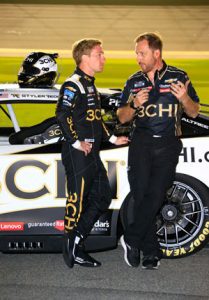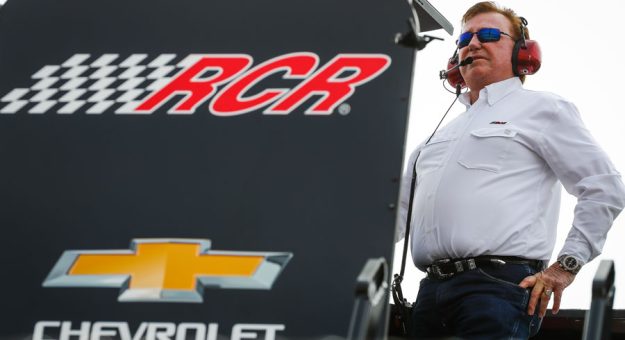For Austin Dillon, the grandson of Richard Childress, the low point of his NASCAR Cup Series career with Richard Childress Racing came during his second and third seasons in the series.
In 2015-’16, RCR’s full-time Cup Series roster consisted of Dillon, Ryan Newman and Paul Menard. During those two seasons, RCR went winless with only 14 top-five finishes among the three drivers.
“They were pretty tough for me in the Cup Series,” Dillon told SPEED SPORT. “I thought Newman did a good job when he jumped into RCR. But we had a lull point there for a couple years. And, you know, just two different people, I guess, different minds.”
When Randall Burnett joined RCR in 2017 as a crew chief, he found an organization that was a “mess.”
And that was on the Xfinity Series side of the team.
“I think it’s come a long way from 2017 to where we’re at right now,” Burnett told SPEED SPORT. “We had five Xfinity cars. … Anytime you got five teams in one building, you got five different opinions from the crew chiefs, five different driving styles on the track. So everybody’s doing something different.
“We operated more like single-car teams at that point. We would lean on each other. But we couldn’t always take what each other was doing. I think that gap has closed since I’ve been here 2017 to where it’s at now.”

Part of that process was the return of Andy Petree.
The crew chief behind Dale Earnhardt’s final two championships in 1993-’94, Petree left RCR after 1995 to start his own race team. He eventually became a TV analyst.
In 2017, Petree returned to the RCR campus in Welcome, N.C., to serve as the team’s vice president of competition.
What was his assessment of the team he found?
“I’m not sure that everybody was buying into the big picture of the program,” Petree told SPEED SPORT. “That wasn’t happening then. And I think that’s the only reason there was an opportunity for me to come in. That’s really what I focused on, I just wanted to try to get everyone really buying into what direction we were going with everything.”
That included changing personnel in different areas of the team and a change in “priorities” when it came to development.
It also involved circling the wagons with Chevrolet.
“I really made a big push to get Chevrolet more involved, because at that time the Chevy teams were basically racing each other,” Petree said. “We were doing all of our programs in parallel. Nobody was collaborating. Chevrolet was giving us this development money. We’re all spending it and doing the exact same thing to try to beat the other one and at that time, Chevy was not winning championships. I made a pretty good effort to try to get everybody on the same page on that.
“It took a couple of years.”
In October 2020, it was announced that Hendrick Motorsports and RCR would team up on research and development of a common Chevrolet engine.
“I think when you step back and look at it, ultimately you have to get to a point to where, when you have these resources and you have these people, we have to do what’s best for Chevrolet, first and foremost, to continue to push their performance and get them back to the front of the field and get them wins and championships,” said Jeff Andrews, the vice president of Hendrick Motorsports at the time of the announcement.
Key pieces of the puzzle for RCR’s rebound were Burnett and driver Tyler Reddick.
After the duo won the 2019 Xfinity Series title, it came time for the call up in 2020, with Reddick taking over the No. 8 Chevrolet that had been Daniel Hemric’s ride the year before.
While Reddick earned six Xfinity Series wins in 2019, Dillon and Hemric combined for just one top-five finish and eight top-10 efforts in the Cup Series. Reddick said that during his title run it was “difficult to watch” the Cup Series teams struggle on Sundays.
“But it was nice knowing at the same time that if we can figure it out on the Xfinity side of the shop, if we can outrun Joe Gibbs and Stewart-Haas on Saturdays, surely, we can figure this out on Sundays,” Reddick told SPEED SPORT.
Simply moving a two-time time Xfinity Series champ to the Cup Series isn’t a cure all.
For Dillon, the key was advancing Reddick’s entire team to the Cup Series ranks.
“It took out a whole group of guys that had been in that Cup shop for a long time,” Dillon said. “It was more of bringing a whole group of people and getting some different outlooks I think in that area, and then keeping some of the good outlooks that were in there. Not saying there was ever bad people, but I just think more like-minded people got in the same area and worked the same way.”
But it wasn’t an overnight change.
RCR won only once in 2020, when a pit-strategy call late at Texas Motor Speedway helped Dillon and Reddick secure a one-two finish and qualified Dillon for the playoffs.
The COVID-19 pandemic limited cohesion.
“Thanks to COVID we went no practice, just starting these races,” Petree said. “That was tough on a rookie (Reddick). And I felt like if we hadn’t had that, we would have made progress quicker. Because Tyler would have been able to get a lot more experience with practice, we’d get to know him better. But it was still a pretty good season.”
Dillon felt he and Reddick “were both pushing each other at different tracks” throughout Reddick’s rookie season.
“Then last year was both of us fighting constantly, every week for top 10s,” Dillon said. “Knocked ourselves out of the points. Getting that win at Texas was a big one to finish there. So different things allowed us to do that and have these runs, and then going into Next Gen, it was a reset for everyone again, to really attack and try and be the best at it.”
Richard Childress was one of the main champions of getting NASCAR to pursue and embrace the Next Gen car, which represented the biggest technological shift for the sport in its 70-year history.
It was RCR who put together the first prototype, which made its maiden voyage with Dillon at the wheel at Richmond (Va.) Raceway in October 2019.
At least part of the calculus in that decision was the desire to have at least a slight advantage over the competition once the car made its debut.
“We felt like it would help us,” RCR President Torrey Galida told SPEED SPORT. “We really wanted to get a strong start, we felt like we had a bit of an advantage because we did so much of the development work for the Next Gen car.”
While Galida said it might be “really difficult to quantify” the advantage RCR received, it gave the team “a level of confidence that we would be competitive.”
When can a team say that it’s “back?”
To be “back” means there was a valley from which they’ve worked to return.
For Richard Childress Racing, excluding the short bursts of winning the Daytona 500, Coca-Cola 600 and the 2020 race at Texas, the valley stretched roughly eight years.
When Reddick led 90 laps and won the first two stages of the February race at Auto Club Speedway, it was a significant accomplishment. Despite not winning, it was the single best race performance by one RCR car since Kevin Harvick’s last year with the organization in 2014.
Galida called the race “bittersweet.”
“We all felt really good about that because he clearly had the dominant car,” Galida said. “We felt like we were in a really good spot to start the season. … We’ve got to close the deal and get some wins.”
Entering the June 5 race at Gateway, RCR had combined for seven top-five finishes — tying its most since 2017 — and 12 top-10 results. Reddick and Dillon had collected four runner-up finishes without scoring an elusive victory.
Richard Childress Racing is not “back.” For Petree, that would constitute multiple race wins.
But the team is closer than it’s been in nearly a decade.
